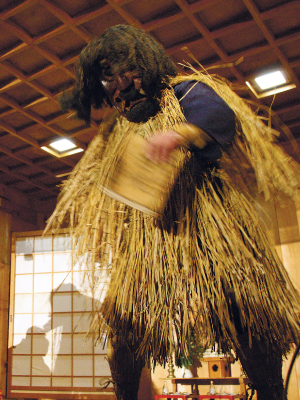

On New Year’s Eve, young men of the various villages dressed as Namahage go from house to house shouting loudly “Are there any crybabies here? Any kids who don’t listen to their parents?” and “Does the woman of the house wake up early?” To the people of Oga, the Namahage are visiting gods that come with the New Year to warn against laziness, and bring protection from illness and disasters, a good harvest, and plentiful food from the mountains and sea. The houses that welcome the Namahage prepare traditional food and sake and offer it graciously to them.
Namahage events used to be held on the Lunar New Year in Oga, but now they are held on Dec.31. Due to a lack of participants to pass on the tradition, the number of areas holding Namahage events has been decreasing year by year. However they have recently been making a comeback. In 1978, Oga’s Namahage were designated officially as an Important Intangible Cultural Asset.

In winter, spending a long time around the hot open hearth causes the hands and feet to blister. In Akita Dialect, these are called Namomi. “Peeling off the blisters” (Namomihagi) is a metaphor for avoiding laziness, and over time, the word became Namahage. “Namomihagi” also has a celebratory meaning as a greeting, during the New Year, brides children, and newcomers are exhorted to“Peel off your blisters”!
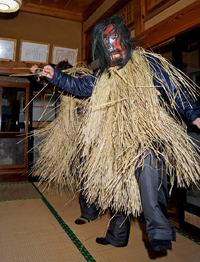
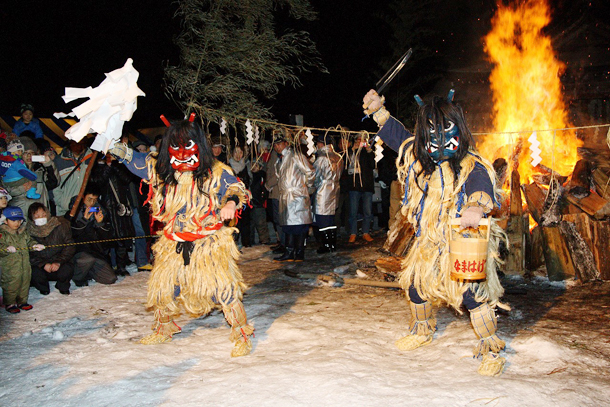
| Deba-bocho and Gohei | Namahage go around carrying a large chopping knife (Deba-bocho) to cut off namomi, in same areas, they also carry gohei, sacred wooden wands hung with paper streamers that symbolize their status as Shinto gods. |
|---|---|
| Men (Mask) | Various materials are used for the mask, such as bark, carved wood, and paper mache molded onto colanders. Nowadays the masks are made of plastic or carved from wood by local craftsmen. |
| Kede | A garment made of straw woven into a coat. This garment symbolizes the Namahage’s divinity as does the mask. It’s also known as a kedashi, kende, and keramino. |
| Habaki | Shin guards made of straw. Wearing the guards symbolizes coming from another place. |
| Waragutsu | Snow boots made of straw to walk down from far away in the snow. |


Picture: Dedication of a peach to the emperor Wu of the Han/Akagami Shrine collection
In the ancient Han dynasty of China, the emperor Wu came to Oga with five bats to find a medicinal plant for an elixir of immortality. The five bats transformed into demons and worked hard for the emperor, but one day, the fives bats asked the emperor “Could you please give us just one day to rest?” Eventually they had a break on the 15th of the New Year. They went down to the villages and stole crops, animals, and even young girls. People in the village were distraught and offered the emperor a deal .If the demons could make a thousand stone steps from the beach to Goshado shrine, located on the summit of the mountain, in a single night before the roosters crowed, they would offer a girl to them every year. If they could not, the demons were never to return. Although people in the village expected that it would be impossible to build a thousand stone steps in a night, the demons made the steps easily. When the demons finished making the 999th stone step, people panicked. But the villagers tricked the demons by having village fool imitate the “cock-a-doodle-doo” of the morning rooster’s crow. The demons were so surprised and mad that they pulled over a thousand-year-old cedar, stuck it into the ground, and stormed back to the mountain. They never came down to the village again.
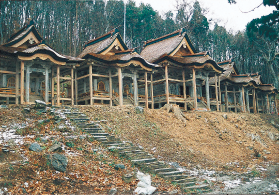
Akagami Shrine Goshado (important cultural property)
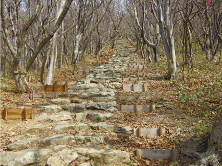
Steps to Goshado Shrine
Honzan and Shinzan mountains in Oga have been holy grounds for shugendo mountain ascetics in training since ancient times. The trainees wore mountain priest (yamabushi) costumes and came down to the village sometimes to pray at each house. According to this theory, the fearsomely dressed trainees may be the origin of the legend.
When Oga is seen far away from the sea, it looks like a mountain rising from the Japan Sea. On this mountain, a god was said to dwell to protect the people of Oga, and Namahage are messengers of the mountain god in this theory.
People who drifted from different countries to the coast of Oga looked like demons because of their different appearances and languages. According to this theory, Namahage originate from these drifters to Japan.
The oldest record of Namahage was in a book named “Oga no Samukaze” (The Cold Wind of Oga) which was authored by Masumi Sugae (1754-1829), an Edo-period travel writer. In the book, he left paintings and detailed explanations about Namahage as “Namomihagi” in the Miyazawa area of Oga, which he visited on the 15th of the New Year in 1811. Additionally, Namahage turn up in the folklore research book “Koshogatsu no Homonsha” (Visitors of the Lunar New Year) by Kunio Yanagita (1875-1962), in“Marebito” (Visitors from the Afterworld) by Shinobu Orikuchi (1887-1953), and in “Nihon Sai Hakken~Geijutsu fudoki~” (Rediscovery of Japan ~ Ancient Art Records) by Okamoto Taro (1911-1996).
A folklore researcher in Oga, Saburo Yoshida (1905-1979), introduced the Namahage of Okura, Wakimoto village in the book “Oga Kampuzanroku Nomin Shuki” (1935). He later surveyed Namahage in all the areas of Southern Akita. His books became a pioneering work of research on Namahage.
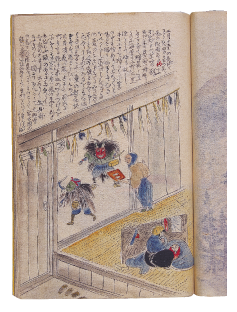
“Oga no samukaze” Akita prefectural museum collection












